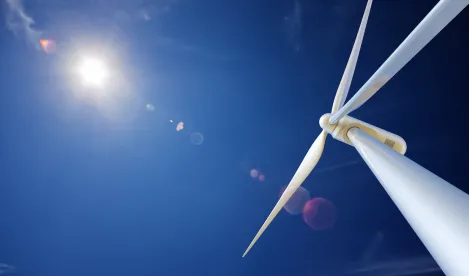With New York Governor Andrew Cuomo pronouncing the state’s process for siting renewable energy projects broken, the New York State legislature late yesterday passed sweeping reforms to the siting of large renewable energy projects proposed by the Governor, setting a firm one-year deadline for final siting decisions, as well as committing to study and plan for the transmission infrastructure needed to support it with a new structure that focuses on expediting the most critical major build-outs of the bulk transmission system to carry needed renewable energy from sites in Upstate New York and off-shore wind platforms to where it is needed by Downstate customers. In February, we wrote that Governor Cuomo’s proposal, submitted to the legislature as an amendment to the annual State budget, signaled a significant shift in thinking about renewable energy siting from a bureaucratic energy regulatory issue to an economic development initiative focused on meeting the progressive mandates of the Climate Leadership and Community Protection Act (CLCPA), while continuing to minimize environmental impacts. The bill that passed the legislature kept the governor’s underlying proposal largely intact while enhancing it in certain respects in ways that may further improve the structure and will become law when the governor approves the budget bills passed by the legislature, a step expected to take place today. The changes to the bill provide additional recognition of the role of local governments and citizens affected by renewable siting, and omit the attempt to standardize local property tax assessments and agreements for payments in lieu of taxes (PILOT). Overall, the new law aspires to site renewable projects in a timelier and more efficient manner.
Today’s new law, to be codified primarily in N.Y. Executive Law § 94-c, may be viewed as favorable by renewable energy developers seeking to site projects in New York as compared to the currently available structure. The law passed today establishes fast-track siting for large renewable projects of 25 MW and above, requiring that a final siting decision must be issued within one year of a complete application. The new law allows projects between 20 and 24 MW to opt into the new regime (the original bill was more inclusive, allowing projects as small as 10 MW to opt in), and allows projects that have begun the current Article 10 process to transition to the new process. The law creates an Office of Renewable Siting (the Office) within the Department of State (not within the state’s economic development agencies as in the original bill), and allows staff from other executive agencies to transfer to the Office with full civil service protections in place.
Under the new law, the Office must set uniform standards and conditions for siting design, construction and operation of renewable projects which is designed to enhance the efficiency of the process given similar issues faced by many of these projects. The standards will be based on conditions common for classes and categories of renewable projects (e.g., solar, wind, and storage), and must continue to avoid or minimize adverse environmental impacts to the extent practicable. The Office must hold four public hearings on the standard (DPS), and the Department of Agriculture and Markets (DAM), will have a consultative role in creating the new standards, but the new office will have the last word. Those environmental impacts that cannot be eliminated through the uniform conditions can be further mitigated by payment of funds dedicated to mitigation measures designed to offset such impacts. An endangered species mitigation bank is established to mitigate threatened and endangered species impacts, which have impeded renewable energy projects in the past. DEC is authorized to contract with a non-profit to administer the fund. A host community benefit also must be provided.
Some criticized the original proposal for “big-footing” local governments, and many of the changes and additions to the bill appear aimed at giving municipalities, local governments, and residents of host communities more of a voice in the siting process, while still retaining the Office’s ability to override local laws that are deemed “unduly burdensome” in light of the CLCPA goals and the environmental benefits of a project. While similar to what was contained in the Article 10 siting law, it now focuses on the need to meet CLCPA requirements in conducting this aspect of the siting process and it remains to be seen whether the Office will be more willing to override local laws seeking to impede renewable projects given the CLCPA requirements that mandate 100% carbon neutrality in the electricity generating sector by 2040. Before the Office may deem a permit complete, an applicant must provide proof of consultation with the affected local government on both substantive and procedural local laws.
The bill also clarifies that there will be an intervenor fund, administered by the New York State Energy Research and Development Authority (NYSERDA), available to local governments and “community intervenors” and paid for by a $1,000 per kW permit fee. In contrast to the intervenor funding under Article 10, however, the fund here is for the participation in public comment or hearings, and to assist local governments in determining whether a project complies with local laws. Because the new law only requires a hearing if the Office finds that there is a substantive and significant issue, the use of intervenor funding to pay for adversarial hearings may be reduced, thereby potentially allowing such proceedings to be concluded more efficiently and in a more timely manner.
The permit completion stage may present some timeline concerns for developers. Under the law, the Office must make a permit completion determination within 60 days. But, the law does not provide a deadline for resubmission of an application in the event the Office determines that an application is incomplete. This may delay the permitting process, as similar delays of permitting determinations have been seen in other contexts, most notably, in natural gas pipelines seeking state-issued permits and certificates. The Public Service Commission’s (PSC) role in this process is reduced to enforcing the permit conditions that the Office puts in place.
Those unhappy with the Office’s final determination on a permit application may challenge the determination in court, but judicial review is expedited and circumscribed. Skipping the trial court altogether, litigants must bring their challenge in the Appellate Division where the host community is located, and, once there, the law directs the court to expedite these cases “with lawful precedence over all other matters.” A prospective litigant will find the court’s review limited to eight items, such as conformity with state and federal law and whether the decision is arbitrary and capricious. Further acknowledging the importance of citizen involvement, the court may also review whether the decision was made pursuant to a process that afforded meaningful involvement of the citizens affected by the facility regardless of age, race, color, national origin, and income.
The reforms do not include uniform local property tax assessment methodologies, or PILOT provisions, which were included in the original bill. The prior bill took on the patchwork of property taxes and PILOT agreements by dictating certain assessment methodologies and requiring consultation with NYSERDA on PILOTs. Those sections were cut from the final bill, and renewable energy developers will, for the time being, need to continue to navigate New York’s local taxing and industrial development authorities to have project property tax levels set or put PILOTs in place.
If developers cannot find, or are otherwise unable or unwilling to proceed with the permitting of, viable sites for projects, the provisions directing NYSERDA to find and permit shovel-ready sites to auction off to developers have been retained. The legislature did put some guard rails on this new program, making it subject to some additional requirements focused on environmental justice communities. NYSERDA also must reinvest any proceeds from the property sales in the program, preventing it from reallocating the funds received from the program, if any, without future legislation. The new law does not require developers to purchase properties from NYSERDA, but rather provides an alternative acquisition method through a public authority that may have substantial access to intelligence on sites such as brownfields, landfills, and retired electric generating facilities.
Finally, taking on transmission, the new law maintains the comprehensive transmission study proposed in the governor’s proposal, which directs that a capital plan and bulk transmission system investment program must be issued just under a year from now. The comprehensive transmission review is directed at both large scale, bulk transmission projects as well as the local and distribution level upgrades that will be needed for the state to meet the CLCPA requirements. The PSC retains its oversight role here, identifying “priority transmission projects” that NYPA then expedites outside of the ordinary NYISO process. For bulk transmission projects, the original bill language was changed to recognize the NYISO process is to be used for a significant portion of public policy based upgrades, require NYPA to solicit interest from third-party “co-participants”, and, for priority projects not substantially in NYPA’s right of way, it must solicit private sector participants through a competitive bidding process, and the project cannot include upgrades to NYPA’s own transmission assets.
This law, implemented in the time frame and as the streamlined process envisions, paves the way for the state to meet the progressive mandates set forth in the CLCPA last year, while acknowledging the importance of the host communities and their residents in the process of siting, as well as the need to continue to minimize significant environmental impacts. By moving the Office out of the energy regulatory sector, and into the realm of DOS’s general state permitting, New York has sought to create a process that gets completed in a timely manner and results in the construction of solar generation projects, storage, and land-based wind projects to meet the CLCPA’s mandates. However, it remains to be seen if the new law will transform the current renewable siting landscape.




 />i
/>i

